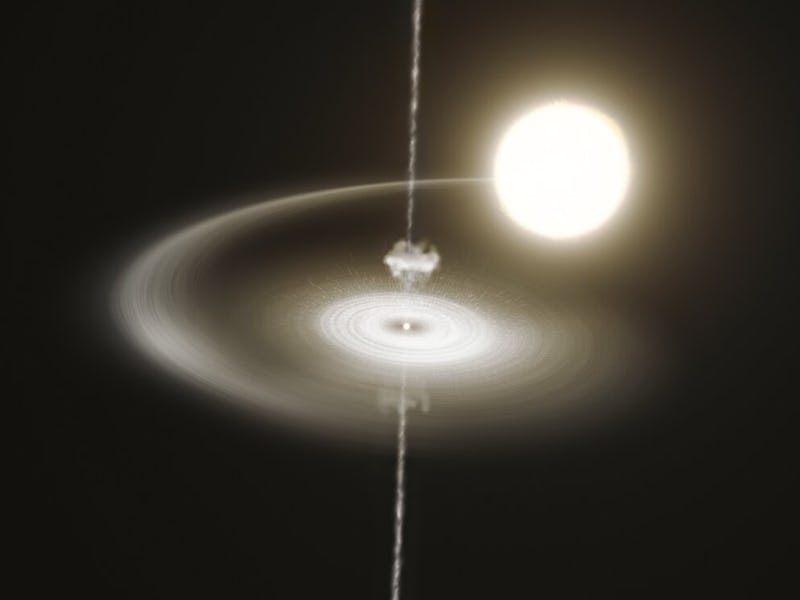Astronomers Solve a Bizarre Mystery About a Dead Star
It turns out that the pulsar J1023 is just a very messy eater.

When a distant pulsar suddenly switched off and then started flickering randomly, astronomers were puzzled — but a team of researchers says they’ve solved the mystery.
It turns out that the pulsar occasionally belches out some of the material it’s stealing from its nearby companion star, which makes its bright polar jets switch on and off every few seconds. New York University Abu Dhabi astrophysicist Christina Baglio and her colleagues recently published their work in the journal Astronomy & Astrophysics.
A Flickering Pulsar
About a decade ago, a pulsar called J1023 — the burned-out, collapsed core of a dead star 4,500 light years away — started doing something bizarre. Normal pulsars are tightly-packed balls of neutrons that spin dizzyingly fast, hundreds of times a second. Their powerful magnetic fields trap electrically charged particles and speed them toward the north and south poles, then shoot them out into space in a blazing beam of charged particles and light. As the pulsar spins, that beam sweeps past Earth like a lighthouse beam, so the pulsar seems to blink (or pulse — hence the name “pulsar”) regularly.
And that’s exactly what J1023 did until several years ago, when that steadily blinking lighthouse beam seemed to switch off and the pulsar’s light became erratic and strange. For a few seconds or a few minutes at a time, J1023 blazes brightly with visible light, ultraviolet light, and X-rays. Then, without warning, the pulsar flickers and goes dim except for powerful streams of radio waves.
Baglio and her colleagues have spent the last nine years studying J1023, and they say they’ve finally solved the mystery of its weird flickering.
Giant Globs of Plasma
J1023 waltzes in a shared orbit with a tiny star (less than a quarter of our Sun’s mass) at a scandalously close distance of just 62,000 miles. To have survived the supernova explosion that left J1023 behind, that star must have once been much more massive or much farther away. About ten years ago, around the time Baglio and co-author Francesco Zelati, of the Institute for Space Sciences, were starting on their graduate theses, J1023 got close enough to start pulling streams of plasma away from its partner.
That’s already enough to make J1023 pretty unusual. Of the 3,500 pulsars listed in the Australia Telescope National Facility Pulsar Catalog, only around 20 are black widow pulsars: ones that are part of binary systems and also pulling material away from their stellar companions.
"If we narrow our focus to the specific class of pulsars to which PSR J1023+0038 belongs, known as the class of transitional millisecond pulsars, this class comprises only three confirmed members, plus a few candidates," Zelati tells Inverse.
Drawn by the pulsar’s irresistible gravity, plasma unspools from the nearby tiny star in a glowing arc, then wraps around J1023, forming a spiraling disc that eventually falls onto the pulsar.
The gas whirling around in the disk gets blasted by pulsar winds, which are powered by the pulsar's super-fast rotation and strong magnetic field and laden with electrons and other fast-moving particles. The pulsar winds give the material in the disk an electrical charge, which makes it easy for the pulsar's magnetic field to trap and carry toward the poles. As that charged, high-speed material blasts outward in a jet, the pulsar glows in light ranging from X-rays to the longer wavelengths our eyes can see.
Baglio and her colleagues call this the pulsar's "high mode," but it never lasts more than a few minutes, and sometimes it only lasts a few seconds.
Every so often, the magnetic-field-powered jets spew out a great glob of plasma all at once: billions of truckloads of plasma in a few seconds. The plasma glob takes enough material out of the disk around the pulsar that the jets sputter and die — at least for a little while. This is the pulsar's “low mode,” when it’s mostly only emitting radio waves stirred up by the ejection of the plasma blob. Within a few seconds, or a few minutes at most, the disk will re-fill and the jet will kick on again, until another plasma glob disrupts the process.
And so J1023 flickers wildly in the darkness of space.
What Happens Next
Baglio and her colleagues pieced that together using data from the creatively named Very Large Telescope (VLT), the Atacama Large Millimeter/submillimeter Array, and ten other telescopes on the ground and in space. In a few years, when the European Southern Observatory’s even more creatively named Extremely Large Telescope is ready to scan the skies, Baglio and her colleagues hope it will give them an even more detailed look at J1023. They’re especially interested in learning more about how and why the pulsar’s jets switch themselves on and off by coughing out those enormous globs of plasma.
Meanwhile, J1023 will keep stripping material away from its tiny partner. Losing so much mass may change the evolutionary fate of the tiny star; it may also change
“Eventually, the system could evolve into a binary consisting of a neutron star and a white dwarf,” Baglio tells Inverse. But we probably won’t get to see anything more dramatic – like a neutron star collapsing even further to become a black hole. According to Baglio, “It is generally very unlikely for a neutron star to accumulate enough mass from its companion to become a black hole.”
Instead, J1023 will probably just keep being weird: an inspiration to us all.
This article was originally published on